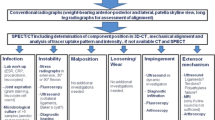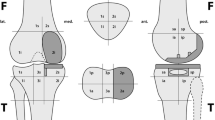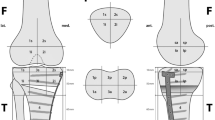Abstract
Objective
To evaluate the differences of bone tracer uptake (BTU) in symptomatic and asymptomatic contralateral knees in patients after reconstruction of the anterior cruciate ligament (ACL-R) and to identify typical BTU patterns and threshold values to differentiate pathological from physiological BTU.
Methods
53 patients after unilateral ACL-R were retrospectively included in the study. The population was subdivided into a group of symptomatic operated knees and a group of contralateral asymptomatic non-operated knees. BTU was measured in SPECT/CT using a validated anatomical localization-scheme and normalized mean BTU values were calculated in both knees. Wilcoxon signed rank-test and Pearson’s rank-correlation coefficient were used (p < 0.05).
Results
Symptomatic knees after ACL-R showed significantly more BTU than asymptomatic ones (p < 0.01).Based on the measured BTU activity in SPECT/CT in symptomatic operated and asymptomatic non-operated knees, intensity thresholds of pathological BTU were established. A BTU threshold of greater than the Median + 1 SD of the asymptomatic non-operated knee was defined as pathological. In both groups the highest mean BTU was found on the femoral, tibial and patellar articular surfaces, the lowest BTU in femoral and tibial regions far from the joint.
Conclusions
The established BTU thresholds for SPECT/CT in knees after ACL-R help to differentiate disease-specific from patient-specific BTU. It could be speculated that BTU in asymptomatic knees equates to the preoperative condition of the knee joint before ACL-R. Therefore, the results of this study help to understand in-vivo loading of the knee and ultimately lead to prediction of development of osteoarthritis in an early stage.




Similar content being viewed by others
References
Hirschmann MT, Schon S, Afifi FK, Amsler F, Rasch H, Friederich NF, et al. Assessment of loading history of compartments in the knee using bone SPECT/CT: a study combining alignment and 99mTc-HDP tracer uptake/distribution patterns. J Orthop Res. 2013;31(2):268–74.
Hirschmann MT, Wagner CR, Rasch H, Henckel J. Standardized volumetric 3D-analysis of SPECT/CT imaging in orthopaedics: overcoming the limitations of qualitative 2D analysis. BMC Med Imaging. 2012;12:5.
Suter B, Testa E, Stampfli P, Konala P, Rasch H, Friederich NF, et al. A novel standardized algorithm using SPECT/CT evaluating unhappy patients after unicondylar knee arthroplasty–a combined analysis of tracer uptake distribution and component position. BMC Med Imaging. 2015;15:11.
Mathis DT, Rasch H, Hirschmann MT. In vivo bone tunnel remodeling in symptomatic patients after ACL reconstruction: a retrospective comparison of articular and extra-articular fixation. Muscles Ligaments Tendons J. 2015;5(4):316–24.
Mathis DT, Hirschmann A, Falkowski AL, Kiekara T, Amsler F, Rasch H, et al. Increased bone tracer uptake in symptomatic patients with ACL graft insufficiency: a correlation of MRI and SPECT/CT findings. Knee Surg Sports Traumatol Arthrosc. 2018;26(2):563–73.
Hirschmann MT, Amsler F, Rasch H. Clinical value of SPECT/CT in the painful total knee arthroplasty (TKA): a prospective study in a consecutive series of 100 TKA. Eur J Nucl Med Mol Imaging. 2015;42(12):1869–82.
Awengen R, Rasch H, Amsler F, Hirschmann MT. Symptomatic versus asymptomatic knees after bilateral total knee arthroplasty: what is the difference in SPECT/CT? Eur J Nucl Med Mol Imaging. 2016;43(4):762–72.
Cook GJ, Ryan PJ, Clarke SE, Fogelman I. SPECT bone scintigraphy of anterior cruciate ligament injury. J Nucl Med. 1996;37(8):1353–6.
Dye SF, Chew MH. The use of scintigraphy to detect increased osseous metabolic activity about the knee. Instr Course Lect. 1994;43:453–69.
Graute V, Feist M, Lehner S, Haug A, Muller PE, Bartenstein P, et al. Detection of low-grade prosthetic joint infections using 99mTc-antigranulocyte SPECT/CT: initial clinical results. Eur J Nucl Med Mol Imaging. 2010;37(9):1751–9.
Cachovan M, Vija AH, Hornegger J, Kuwert T. Quantification of 99mTc-DPD concentration in the lumbar spine with SPECT/CT. EJNMMI Res. 2013;3(1):45.
Kim J, Lee HH, Kang Y, Kim TK, Lee SW, So Y, et al. Maximum standardised uptake value of quantitative bone SPECT/CT in patients with medial compartment osteoarthritis of the knee. Clin Radiol. 2017;72(7):580–9.
Beck M, Sanders JC, Ritt P, Reinfelder J, Kuwert T. Longitudinal analysis of bone metabolism using SPECT/CT and (99 m)Tc-diphosphono-propanedicarboxylic acid: comparison of visual and quantitative analysis. EJNMMI Res. 2016;6(1):60.
Hirschmann MT, Mathis D, Afifi FK, Rasch H, Henckel J, Amsler F, et al. Single photon emission computerized tomography and conventional computerized tomography (SPECT/CT) for evaluation of patients after anterior cruciate ligament reconstruction: a novel standardized algorithm combining mechanical and metabolic information. Knee Surg Sports Traumatol Arthrosc. 2013;21(4):965–74.
Hirschmann MT, Mathis D, Rasch H, Amsler F, Friederich NF, Arnold MP. SPECT/CT tracer uptake is influenced by tunnel orientation and position of the femoral and tibial ACL graft insertion site. Int Orthop. 2013;37(2):301–9.
Rubello D, Caricasulo D, Borsato N, Chierichetti F, Zanco P, Ferlin G. Three-phase bone scan pattern in asymptomatic uncemented total knee arthroplasty. Eur J Nucl Med. 1996;23(10):1400–3.
Henckel J, Richards R, Lozhkin K, Harris S, Baena FM, Barrett AR, Cobb JP. Very low-dose computed tomography for planning and outcome measurement in knee replacement. The imperial knee protocol. J Bone Joint Surg Br. 2006;88(11):1513–8.
Hirschmann MT, Davda K, Iranpour F, Rasch H, Friederich NF. Combined single photon emission computerised tomography and conventional computerised tomography (SPECT/CT) in patellofemoral disorders: a clinical review. Int Orthop. 2011;35(5):675–80.
Horger M, Eschmann SM, Pfannenberg C, Storek D, Vonthein R, Claussen CD, et al. Added value of SPECT/CT in patients suspected of having bone infection: preliminary results. Arch Orthop Trauma Surg. 2007;127(3):211–21.
Hirschmann MT, Iranpour F, Konala P, Kerner A, Rasch H, Cobb JP, et al. A novel standardized algorithm for evaluating patients with painful total knee arthroplasty using combined single photon emission tomography and conventional computerized tomography. Knee Surg Sports Traumatol Arthrosc. 2010;18(7):939–44.
Fritschy D, Daniel DM, Rossman D, Rangger C. Bone imaging after acute knee hemarthrosis. Knee Surg Sports Traumatol Arthrosc. 1993;1(1):20–7.
Buck FM, Hoffmann A, Hofer B, Pfirrmann CW, Allgayer B. Chronic medial knee pain without history of prior trauma: correlation of pain at rest and during exercise using bone scintigraphy and MR imaging. Skeletal Radiol. 2009;38(4):339–47.
Sharif M, George E, Dieppe PA. Correlation between synovial fluid markers of cartilage and bone turnover and scintigraphic scan abnormalities in osteoarthritis of the knee. Arthritis Rheum. 1995;38(1):78–81.
Kim HR, So Y, Moon SG, Lee IS, Lee SH. Clinical value of (99 m)Tc-methylene diphosphonate (MDP) bone single photon emission computed tomography (SPECT) in patients with knee osteoarthritis. Osteoarthr Cartil. 2008;16(2):212–8.
Torres L, Dunlop DD, Peterfy C, Guermazi A, Prasad P, Hayes KW, et al. The relationship between specific tissue lesions and pain severity in persons with knee osteoarthritis. Osteoarthr Cartil. 2006;14(10):1033–40.
Rechsteiner J, Hirschmann MT, Dordevic M, Falkowski AL, Testa EA, Amsler F, et al. Meniscal pathologies on MRI correlate with increased bone tracer uptake in SPECT/CT. Eur Radiol. 2018;28(11):4696–704.
Blake GM, Frost ML, Fogelman I. Quantitative radionuclide studies of bone. J Nucl Med. 2009;50(11):1747–50.
Filippi L, Manni C, Pierantozzi M, Brusa L, Danieli R, Stanzione P, et al. 123I-FP-CIT semi-quantitative SPECT detects preclinical bilateral dopaminergic deficit in early Parkinson’s disease with unilateral symptoms. Nucl Med Commun. 2005;26(5):421–6.
Shiraishi S, Tomiguchi S, Utsunomiya D, Kawanaka K, Awai K, Morishita S, et al. Quantitative analysis and effect of attenuation correction on lymph node staging of non-small cell lung cancer on SPECT and CT. Am J Roentgenol. 2006;186(5):1450–7.
Schweizer T, Schiapparelli FF, Rotigliano N, Rasch H, Amsler F, Hirschmann MT. Patterns of bone tracer uptake on SPECT-CT in symptomatic and asymptomatic patients with primary total hip arthroplasty. Eur J Nucl Med Mol Imaging. 2018;45(2):283–91.
Acknowledgements
Felix Amsler kindly provided statistical advice for this manuscript. The authors would like to thank Mr Patrick Jaeger for the graphical formatting.
Funding
The authors state that this work has not received any funding.
Author information
Authors and Affiliations
Corresponding author
Ethics declarations
Conflict of interest
The authors declare that they have no conflict of interests.
Ethics approval
All procedures performed in studies involving human participants were in accordance with the ethical standards of the institutional and/or national research committee and with the 1964 Helsinki declaration and its later amendments or comparable ethical standards.
Informed consent
All patients gave their informed consent and the study was approved by the local ethical committee (Ethikkommission Nordwest- und Zentralschweiz 2016-01509).
Additional information
Publisher’s Note
Springer Nature remains neutral with regard to jurisdictional claims in published maps and institutional affiliations.
Rights and permissions
About this article
Cite this article
Mathis, D.T., Büel, L., Rasch, H. et al. Distribution of bone tracer uptake in symptomatic knees after ACL reconstruction compared to asymptomatic non-operated knees: a method for better differentiating patient-specific from disease-specific bone tracer uptake in SPECT/CT. Ann Nucl Med 33, 201–210 (2019). https://doi.org/10.1007/s12149-018-01324-7
Received:
Accepted:
Published:
Issue Date:
DOI: https://doi.org/10.1007/s12149-018-01324-7




